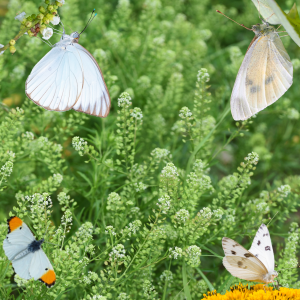A handful of the “lawn ornaments” that will be featured in this blog series. Top row (left to right): sunshine mimosa, perennial peanut, frogfruit, and fleabane. Bottom row (left to right): pennywort, Lobelia, Florida snow, and blue-eyed grass.
Welcome to our Lawn Ornament blog series, where we explore the plethora of micro-plants that can help create a biodiverse, predominantly green, yet also delightfully colorful lawn that requires much less maintenance than a traditional grass lawn.
Many homeowners find it difficult and costly to maintain a “traditional” lawn, one largely dominated by a single grass cultivar. Embracing a biodiverse landscape can ease the frustration and save money, with the added bonus of providing ecological benefits. This “Lawn Ornament” series will provide a road map to that goal. Along the way, we’ll showcase volunteer “weeds” and commercially available ground covers that can improve upon the biodiversity of our lawns. We will also offer you tips and techniques to adopt and embrace this biodiverse approach. Breaking free from tradition, we can transform yards and neighborhoods to vibrant, beautiful mixed-mowable ecosystems.
Make sure to check out the Starter Guide: Embracing Lawn Ornaments: A Starter Guide
This plant is one that peaks in spring, and is a prime example of the importance of No Mow March.
Peppergrass
Along the roadsides during spring in Florida, one particular wildflower can stand out, not just for its delicate beauty but also for it’s abundance and for its crucial role in supporting local ecosystems. Meet Peppergrass (Lepidium virginicum), a member of the Brassicaceae mustard family that often goes unnoticed despite its significant presence in our area.

A Super Host for Butterflies
One of the remarkable aspects of peppergrass is its role as a host plant for numerous different butterfly species in Florida. As we approach the warmer months, it’s not uncommon to witness endless flurries of white butterflies dancing gracefully in the air, especially in areas with citrus groves. These important butterflies, including the Cabbage White Butterfly (Pieris rapae), Great Southern White Butterfly (Ascia monuste), Checkered White Butterfly (Pontia protodice), and Falcate Orange Tip Butterfly (Anthocharis midea) rely on peppergrass as a vital host plant during their larval stage. This symbiotic relationship highlights the importance participating in No Mow March to let native plant species like peppergrass continue to support vital pollinators.
An Edible Gem
Beyond its ecological significance, peppergrass also boasts an extensive ethnobotanical history. Historically, indigenous communities utilized various parts of the plant for culinary and medicinal purposes. Every part of the plant from the seed, to the foliage, to the root has been used in recipes from the early days of the United States. The strong, peppery taste of its seeds makes it an excellent substitute for black pepper. This is the namesake source of one of it’s common names, Poor Man’s Pepper. However, a word of caution: while peppergrass can be edible, it’s crucial to exercise caution and seek expert guidance before trying it. Avoid harvesting peppergrass from areas near roadsides or locations where herbicides and pesticides may have been applied, as these chemicals can contaminate the plant and pose health risks.
The Misunderstood Wildflower
Despite its invaluable ecological roles and culinary versatility, peppergrass often finds itself labeled as a weed by many. However, this perception overlooks its status as a native wildflower and its essential contributions to local biodiversity. Instead of viewing peppergrass as a nuisance, we could recognize its resilience and adaptability along roadsides and as a lawn ornament. It does contribute to the rich tapestry of Florida’s fauna and landscapes. In the coming months let us marvel at the sight of the uncountable White Butterflies, and remember humble peppergrass for its role in bringing them about.
Resources
- UF/IFAS EREC on Peppergrass: https://erec.ifas.ufl.edu/weed-id/virginia-pepperweed/
- Florida Wildflower Foundation on Peppergrass: https://www.flawildflowers.org/flower-friday-lepidium-virginicum/
- UF/IFAS Blogs on Peppergrass: https://blogs.ifas.ufl.edu/bakerco/2024/03/01/pepperweed/
- UF/IFAS MREC on Peppergrass: https://mrec.ifas.ufl.edu/research/weedsbyflowercolor/white/lepidiumvirginicum/
During the preparation of this work, the author used ChatGPT to help build the blog post. After using this tool/service, the author reviewed and edited the content, and takes full responsibility for the content of the publication.
 6
6

